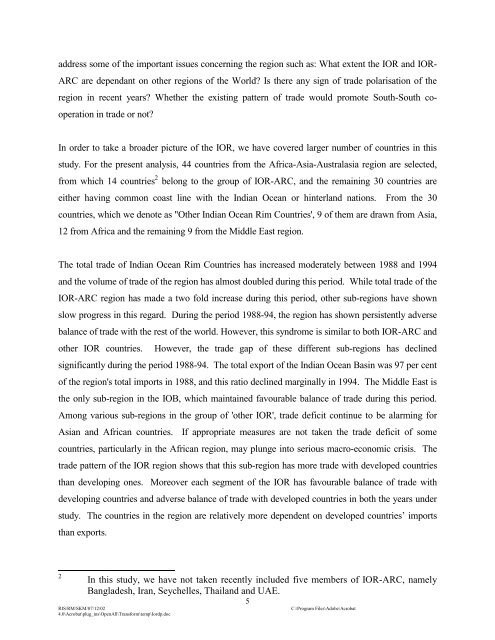dp11_pap
dp11_pap
dp11_pap
You also want an ePaper? Increase the reach of your titles
YUMPU automatically turns print PDFs into web optimized ePapers that Google loves.
address some of the important issues concerning the region such as: What extent the IOR and IOR-<br />
ARC are dependant on other regions of the World? Is there any sign of trade polarisation of the<br />
region in recent years? Whether the existing pattern of trade would promote South-South cooperation<br />
in trade or not?<br />
In order to take a broader picture of the IOR, we have covered larger number of countries in this<br />
study. For the present analysis, 44 countries from the Africa-Asia-Australasia region are selected,<br />
from which 14 countries 2 belong to the group of IOR-ARC, and the remaining 30 countries are<br />
either having common coast line with the Indian Ocean or hinterland nations. From the 30<br />
countries, which we denote as "Other Indian Ocean Rim Countries', 9 of them are drawn from Asia,<br />
12 from Africa and the remaining 9 from the Middle East region.<br />
The total trade of Indian Ocean Rim Countries has increased moderately between 1988 and 1994<br />
and the volume of trade of the region has almost doubled during this period. While total trade of the<br />
IOR-ARC region has made a two fold increase during this period, other sub-regions have shown<br />
slow progress in this regard. During the period 1988-94, the region has shown persistently adverse<br />
balance of trade with the rest of the world. However, this syndrome is similar to both IOR-ARC and<br />
other IOR countries. However, the trade gap of these different sub-regions has declined<br />
significantly during the period 1988-94. The total export of the Indian Ocean Basin was 97 per cent<br />
of the region's total imports in 1988, and this ratio declined marginally in 1994. The Middle East is<br />
the only sub-region in the IOB, which maintained favourable balance of trade during this period.<br />
Among various sub-regions in the group of 'other IOR', trade deficit continue to be alarming for<br />
Asian and African countries. If appropriate measures are not taken the trade deficit of some<br />
countries, particularly in the African region, may plunge into serious macro-economic crisis. The<br />
trade pattern of the IOR region shows that this sub-region has more trade with developed countries<br />
than developing ones. Moreover each segment of the IOR has favourable balance of trade with<br />
developing countries and adverse balance of trade with developed countries in both the years under<br />
study. The countries in the region are relatively more dependent on developed countries’ imports<br />
than exports.<br />
2<br />
In this study, we have not taken recently included five members of IOR-ARC, namely<br />
Bangladesh, Iran, Seychelles, Thailand and UAE.<br />
RIS/RM/SKM/07/12/02 C:\Program Files\Adobe\Acrobat<br />
4.0\Acrobat\plug_ins\OpenAll\Transform\temp\Iordp.doc<br />
5
















